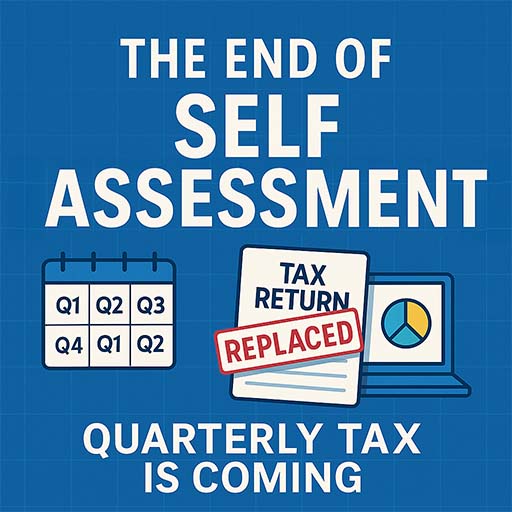Following many delays with the original roadmap, HMRC are plowing forward with bringing its Making Tax Digital (MTD) scheme. In its next phase it will start replacing Self Assessment for income tax, from a once a year tax filing to a quarterly reporting of income and expense. A shifts of focus to continuous, real-time digital reporting. HMRC's aim is to reduce errors, increase accuracy, and simplify the process for both taxpayers and themselves.
The current once a year paper or online tax return submission will be swapped for quarterly updates and a final year-end declaration. The use of strict digital record-keeping and mandatory usage of HMRC-approved software, both small businesses and individual taxpayers are expected to see tangible benefits in terms of time savings and accuracy. HMRC are hoping this will go some way to reducing the tax gap (the difference between expected tax take and what is actually received by the revenue) and raise billions over time.
The journey of Making Tax Digital began with the VAT segment. In April 2019, VAT-registered businesses with turnovers above a higher threshold were required to adopt MTD-compliant software for record keeping and submission. This phase served as a testing ground and, by April 2022, the digital submission process had been extended to include all VAT-registered businesses. The success of MTD for VAT paved the way for this next phase we'll be seeing next year.
What exactly is changing with Making Tax Digital?
Starting April 2026, following the last delay, MTD for Income Tax will target self-employed individuals and landlords with income exceeding £50,000. For people in this bracket, instead of the end-of-year annual submissions, they will be required to update their records quarterly, culminating in a final confirmation declaration.
As the system is rolled out in phases, the income thresholds for being forced to use MTD will gradually be lowered and eventually everyone who currently files a tax return will be under the new system.
Taxpayers will submit quarterly updates that reflect real-time data on income and expenses, supplemented by the one final declaration at the end of the cycle for adjustments.
The quarterly submissions offer several advantages. The main on being highlighted is the reduction in end-of-year rushes that have traditionally plagued the self-assessment season. With the new regular reporting schedule, taxpayers are hoped to be able to keep a closer track of their tax liabilities and promptly address any discrepancies or errors in their accounts.
HMRC will not be offering software (unlike the current online filing setup) so people will need to have their digital records maintained through HMRC-approved software such as Xero, QuickBooks, Sage, or FreeAgent.
What are my requirements issues Under Making Tax Digital
- Taxpayers must maintain digital records of all relevant financial transactions using software that meets HMRC standards. The duty to update records on a quarterly basis means that businesses and individuals must engage more frequently with their financial data with real-time tax management.
- Quarterly updates are cumulative and show totals for each income and expense category. Each business type (self-employed, landlord) requires separate quarterly submissions. However, these are not mini tax returns so don't require tax calculations or adjustments.
- Records should ideally be kept in real-time, but must be in place before filing quarterly updates.
- All transactions must be categorised according to HMRC's specified categories.
- For those below the VAT threshold, simplified three-line accounting is permitted (income, expenses, profit).
The reporting schedule follows fixed quarters:
- Quarter 1: 6 April - 5 July (due by 7 August).
- Quarter 2: 6 April - 5 October (due by 7 November).
- Quarter 3: 6 April - 5 January (due by 7 February).
- Quarter 4: 6 April - 5 April (due by 7 May).
- Final Declaration (required within 9 months of the final quarter - by January 31st).
- The annual final declaration includes: Adjustments to quarterly reported information, Additional income declarations, Claims for allowances and reliefs, Final tax calculations.
- The software used will be capable of transmitting the necessary data securely to HMRC. Unlike the previous self-assessment system, where HMRC provided an online filing portal, MTD places the onus on third-party software providers to ensure compliance. The software on offer provides a wide range of tax related needs from record-keeping and expense tracking to the automated calculation and submission of quarterly updates.
- Individuals facing significant barriers to digital adoption due to age, disability, or lack of access to reliable internet may be granted exemptions. In addition, those with incomes below the stipulated thresholds are not required to transition immediately.
How does Making Tax Digital compare with the current Self Assessment method?
Aside from the replacement of one annual tax return submission with quarterly digital submissions, another key difference lies in the penalty structure. Under the Self-Assessment system, penalties were imposed for late submissions, but under MTD, a points-based system is employed. After a set number of missed deadlines, escalating penalties apply. This approach is designed to incentivise timely updates and continuously encourage compliance throughout the year.
HMRC's online filing system is no longer available under MTD, but software solutions such as Xero, QuickBooks, Sage, FreeAgent, and Zoho Books not only comply with HMRC’s specifications but also offer additional features like real-time dashboards, expense categorisation, and forecasting tools. For those accustomed to traditional spreadsheets, bridging software is available to link existing records to the new digital systems, ensuring a smoother transition.
Are there any guides or tutorials to help with using Making Tax Digital?
Detailed guides, FAQs, and webinars aimed at demystifying the MTD process are on HMRC's website. Professional accountants and tax advisors are also offering bespoke services to ensure that businesses and self-employed individuals adapt seamlessly to the new regime.


